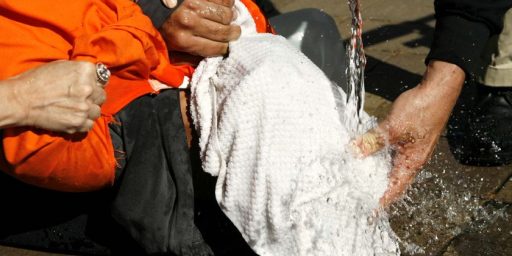O’ROURKE IN IRAQ
Atlantic Unbound features an interview with P. J. O’Rourke about his experiences in Iraq and Kuwait that were the subject of “The Backside of War,” a piece that appears in the December issue. I read that article last night and again reaffirmed my opinions that 1) Atlantic Monthly is the best general interest magazine being published and 2) O’Rourke is unrivaled in his ability to convey the essence of a situation from the ground up.
As a lead-in to the interview, we have an excerpt from the piece (not yet available in its entirety online) that illustrates this perfectly. O’Rourke describes the chaos that was the Kuwaiti Red Crescent Society’s distribution of food in Safwan:
There was no reason for people to clobber one another. Even assuming that each man in the riot–and each boy–was the head of a family, and assuming the family was huge, there was enough food in the truck. Mohammed al-Kandari, a doctor from the Kuwait Red Crescent Society, had explained this to the Iraqis when the trailer arrived…. Al-Kandari had persuaded the Iraqis to form ranks. They looked patient and grateful, the way we privately imagine the recipients of food donations looking when we’re writing checks to charities. Then the trailer was opened, and everything went to hell.
***
Aid seekers in England would queue automatically by needs, disabled war vets and nursing mothers first. Americans would bring lawn chairs and sleeping bags, camp out the night before, and sell their places to the highest bidders. Japanese would text-message one another, creating virtual formations, getting in line to get in line. Germans would await commands from a local official, such as the undersupervisor of the town clock. Even Italians know how to line up, albeit in an ebullient wedge. The happier parts of the world have capacities for self-organization so fundamental and obvious that they appear to be the pillars of civilization … But here–on the road to Ur, in the Tigris-Euphrates Valley … nothing was supporting the roof.
Thomas Friedman would likely have come to a similar conclusion–but he would have had tea with a village elder and taken his word for it rather than standing atop the truck and watching for himself.
Below are some excerpts from the interview itself:
Had you applied for one of the embedded positions?
Not at all. I had no desire to do that whatsoever. Summer camp was bad enough. One of the few benefits of being a journalist is that you’re NOT in the Army. The whole idea of putting you in the Army and not giving you a gun–gee, no thanks. That was the sort of thing that the dumber kind of conscientious objector in Vietnam wound up doing.
What was Kuwait like on a day-to-day basis?
BORING! You can get a drink—sort of. It was $140 a bottle for one of those 750 ml Johnnie Walker red labels. So that was out. There really just wasn’t much to do. And I didn’t have a lot of work to do. You’re just sort of sitting there.
Were you struck by the differences between Iraq and Kuwait?
It’s amazing. The Ministry of Information, which is part of the Department of Moral Guidance, ran a few little day trips for reporters, and one of them was with the Kuwaiti Red Crescent to bring food relief to a couple of these towns right over the Kuwait border. It was just amazing when you crossed that border, because Kuwait is very, very rich. I call it in my piece “Houston without Enron—or beer.”
Iraq is just impoverished. The town of Safwan is right on the border. It was a collection of cement hovels—a very dirty place, but with little war damage. There was more war damage on the Kuwait side. When things had been destroyed back in ’90, the Kuwaitis just left the ruins and built something new beside it. So, there’s all this war wreckage out in the Kuwaiti desert that they never bothered to remove. You get on the Iraq side, and there’s no visible war damage—maybe some right by the customs gates, but other than that, the town of Safwan is untouched, and it is just a mess. It looks like the old Soviet Union, done in kind of a Mexican style, except without any of the color. And then these old farmsteads out in the semi-desert around there–we’re talking really primitive. I’ve traveled around the Middle East quite a bit. I’ve seen this kind of poverty in Egypt—no, actually, this was worse.
And did the people reflect that?
The people were a raggedy bunch. They weren’t really starving. I didn’t see any signs of malnutrition in the children. People were not skeletal. People didn’t seem to be starving, but they were really a rag-tag bunch. Baghdad is the same. The great majority of Baghdad is a slum–a lot of it’s new, but it’s still slum. It’s usually this concrete-block, one-room design with a door and a window, arranged one-up, one-down, often with a shop with nothing in it on the first floor, and then a one-room apartment above it. There’s street after street after street of that stuff.





